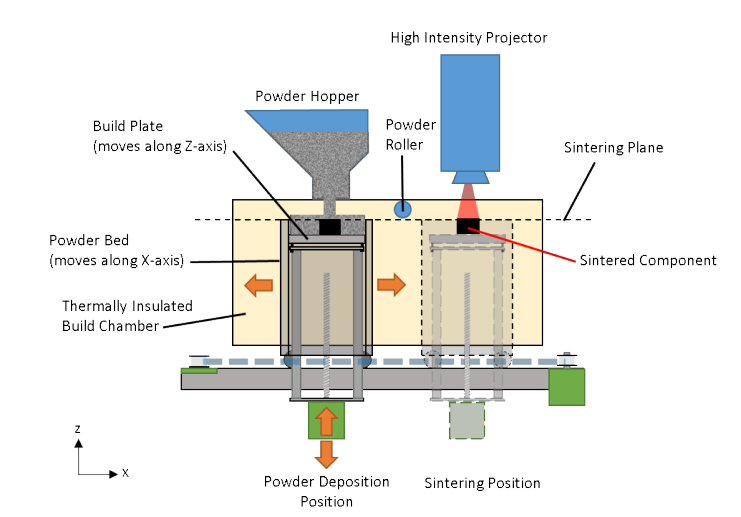3D printing is going hardcore for the military, with a team of developers recently testing materials for electronics meant to withstand harsh environments. The details are revealed in “Mechanical and Temperature Resilience of Multi-Material Systems for Printed Electronics Packaging,” outlining the use of two different 3D printing techniques for comparing materials that would be suitable in remote locations under challenging conditions.
Research and testing were performed by:
- U.S. Air Force Research Laboratory
- Oak Ridge National Laboratory
- Ball Aerospace & Technologies Corporation
- Brigham Young University
- S. Army RDECOM-ARDEC
- Sciperio (research group for nScrypt)
The nScrypt Factory in a Tool (FiT) platform, accompanied by a SmartPump microdispensing tool head, was the main system relied on for 3D printing the device meant to simulate electronics packaging. The sample part was comprised of cured conductive paste circuit (DuPont CB028) on a substrate (using Kapton® and FR4) and a packaging cylinder without a cap.
A powder bed fusion laser projection system developed by the University of South Florida, known as Large Area Projection Sintering (LAPS), was used to make comparison samples. The goal was to create and test electronics packages that would not only be strong enough to hold up to difficult environments, but also protect the materials inside—meaning that thermal expansion had to be kept to a minimum to avoid stresses on the samples.

LAPS system, which fuses entire 2D cross-sections with a single quick exposure. A powder hopper then deposits powder before a counter-rotating roller levels a new uniform layer for sintering. The thermal camera which monitors the process is not shown here for clarity.
Following Military Standard (MIL STD) 883 K, the device was tested for resiliency in terms of:
- Die shear strength
- Temperature cycling
- Thermal shock
- High G loading by mechanical shock
 Although there were some concerns regarding “open circuits, increases in resistance, and delamination,” overall the results were successful as the DW Master Bond epoxy devices made with the nScrypt FiT were able to stand up to high temperatures, and both mechanical and thermal shock. They also performed extremely well when evaluated for die shear strength failure criteria.
Although there were some concerns regarding “open circuits, increases in resistance, and delamination,” overall the results were successful as the DW Master Bond epoxy devices made with the nScrypt FiT were able to stand up to high temperatures, and both mechanical and thermal shock. They also performed extremely well when evaluated for die shear strength failure criteria.
While this project propels the military further ahead in creating durable devices, it also serves as a great example of the advantages in using hybrid digital manufacturing—relying not just on the wonders of 3D printing via extrusion or paste deposition here, but also in using convention techniques when required, such as milling, laser machining, and more.
“Hybrid manufacturing can also decrease the device form factor by conforming electronics to the 3D structure,” explained the authors in their paper. “This unlocks unique devices and architectures that are impossible to fabricate with planar electronics manufacturing.”
These systems are also helpful in 3D printing affordable but high-performance components like sensors and antennas; historically though, issues have arisen due to “significant variability” in functionality of such devices. Regarding the materials used for this project, the authors concluded that the MB components did display the required strength for extreme temperatures, as well as “high acceleration” on both substrates.
The LAPS samples, while still demonstrating the necessary accuracy and strength, raised concern in terms of the Nylon 12 as there was weakening noted during mechanical shocks, electrical changes, and temperature cycling. Micro-cracks in the conductivity paste, as well as water absorption may have been to blame.
“Further studies are required to understand these failure modes in some of the LAPS samples and refine the process to address them,” said the researchers.
Individuals involved in testing: Clayton Neff, U.S. Air Force Research Laboratory, Fuzes Branch, Munitions Directorate, Eglin AFB; Justin Nussbaum, Oak Ridge National Laboratory; Chris Gardiner, Ball Aerospace and Technologies Corporation; Nathan B. Crane, Brigham Young University, Department of Mechanical Engineering; James L. Zunino, U.S. Army RDECOM-ARDEC Picatinny Arsenal; and Mike Newton, Sciperio, Inc. (nScrypt’s research arm), Orlando, FL.
This project marks one of many that both Sciperio and nScrypt have been involved in recently, from developing a new in situ 3D printing inspection system to working with the U.S. Army, the U.S. Air Force previously too, and delivering a system last year to the Australian Defense Department.
[Source / Images: ‘Mechanical and Temperature Resilience of Multi-Material Systems for Printed Electronics Packaging’]Subscribe to Our Email Newsletter
Stay up-to-date on all the latest news from the 3D printing industry and receive information and offers from third party vendors.
You May Also Like
3D Printing News Briefs, April 13, 2024: Robotics, Orthotics, & Hypersonics
In 3D Printing News Briefs today, we’re focusing first on robotics, as Carnegie Mellon University’s new Robotics Innovation Center will house several community outreach programs, and Ugogo3D is now working...
Rail Giant Alstom Saves $15M with 3D Printing Automation Software 3D Spark
3D Spark has entered into a three-year deal with the rail giant Alstom. Alstom, a transport behemoth with annual revenues of $16 billion, specializes in the manufacture of trains, trams,...
Meltio Expands Global Reach with New Partnerships in the Americas and Europe
Spanish 3D printing manufacturer Meltio has expanded its sales network across the globe. With the addition of three new partners in the United States, Brazil, Argentina, and Italy, Meltio aims...
3D Printing Webinar and Event Roundup: April 7, 2024
Webinars and events in the 3D printing industry are picking back up this week! Sea-Air-Space is coming to Maryland, and SAE International is sponsoring a 3D Systems webinar about 3D...


































